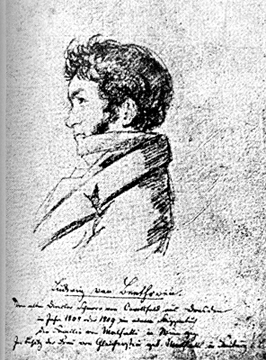|
Beethoven's |
 Ludwig van Beethoven around 1808 Drawing by Ludwig Schnorr von Carolsfeld |
When we look at the genre of Sonatas for Pianoforte and Violoncello in the overall scheme of Beethoven's works, we might almost be tempted to state that he let a decade each pass by before he began to compose a new cello sonata or set of sonatas: From our Biographical Pages, we know that Beethoven already wrote two compositions of this genre during his Berlin visit of 1796, namely for Duport, the Violoncellist of King Friedrich II of Prussia, and that they were very well received there. While these were published by Artaria in Vienna in 1797, Thayer reports that the first sketches to the next work of this genre, Op. 69, were found among the sketches to the Fourth Piano Concerto and the Fifth Symphony in 1806, and again a decade later, namely in 1815, Beethoven wrote the last two Cello Sonatas, Op. 102 .
Most musicologists divide Beethoven's works into three creative periods, namely into his first, classical period up to about 1801 - 1802, thus the first decade of his stay in Vienna, in which influences of his predecessors Mozart and Haydn can be found side-by-side with the emergence of his own style, his second, so-called heroic period from approximately 1803 to 1815, in which, as Solomon points out, Beethoven was able to fill the originally French heroic style of a Mehul with actual artistic tension, and his last, rather transcendent and spiritual period from 1815 to 1827. As lay friends of his music we have at least the possibility of reading all we can read about this issue and also of trying to find out, ourselves, if we can hear differences between these styles in Beethoven's works. Whatever the outcome of these explorations may be, we can also observe here that Beethoven's Cello Sonatas can be found in all three style periods: Op. 5/1 and 5/2 in the first period, Op. 69 in the second period and Op. 102 in the last period. In our exploration of this issue, we might also find a look at the most important characteristics of each period very helpful.
What is Beethoven's first creative period characterized by? With respect to this period, we have already had occasion to observe that during this period (1795 to 1802/1803), Beethoven tried to establish himself as a piano virtuoso and that he also wrote works in this genre particularly for that purpose but that he also successively mastered each compositional genre of the chamber music category (to also include his first set of Cello Sonatas, Op. 5/1 and 5/2 of 1796) and arrived at writing his first and second symphonies even before the onset of his second creative period and in doing so moved more and more away from the influences of his predecessors Mozart and Haydn, while he was only able to display his capabilities outside of Vienna in 1796 and 1798. This might mainly have been due to the onset of his loss of hearing which gradually also led into the crisis of 1801 - 1802 with the creative result of the onset of his new, heroic style period. As to whether his third Cello Sonata, Op. 69 can actually be considered as representative of the heroic style, should be left to the judgment of each listener. The question as to whether or not already his mourning period over the loss of his Immortal Beloved of 1812 - 1813 ushered in a transition towards his last and third creative period is at least worth considering, particularly in light of the fact that, at the latest, his brother's November 15th, 1815, death, clearly marked all works composed thereafter as belonging to the third creative period, while his third set of Cello Sonatas, Op. 102/1 and 102/2, was still written during the spring and summer of that year in the relaxed company of Countess Erdödy and her entourage, albeit with his brother's final illness as a foreboding of things to come. Would this not, at least, indicate that, while such a division of works into style periods is very helpful as a general guideline, this division should not be applied too literally?
Therefore we hope that the following creation histories of each group of sonatas will be able to assist you, together with your further listening experiences and further readings, in your finding your own answers to these questions, and we wish you a great deal of reading enjoyment in the process!
Sonatas for Pianoforte and Violoncello, Op. 5/1 and 5/2
Read up on all details, including those of Beethoven's far-reaching conclusions!:-)Sonata for Pianoforte and Violoncello, Op. 69
Here, the far-reaching element refers mainly to the time span of the creation and initial as well as repeat performances of this work. However, also the human, all too human Beethoven sends his greetings again!Sonatas for Pianoforte and Violoncello, Op. 102/1 and 102/2
Already a work belonging to the third creative period? Some details on this, but also on a summer among good musical friends!Interesting Cello Links!
...on great virtuosos of the past and present, but also on other interesting Cello topics!


